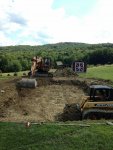Well, yesterday I registered on TFP and today was day one of construction of my new IG pool! The picture is of how my "pool" looks after day one.
I searched for an answer to this question but couldn't find it: After the pool is filled for the first time, what can I expect in terms of chemical readings and is it likely that we can swim immediately - or once the water temp reaches a comfortable level (we will have a heater)? Also, should I avoid swimming until all readings are within the recommended ranges or are some readings more important than others regarding a first swim in a new pool? I assume that it depends on the quality of the water used to fill, we are using a company called Aqua-Duck which specializes in providing water for pools. Aqua-Duck says they deliver "clean, clear water straight from the municipal water supply."
My pool builder says he'll finish on or about Aug 28 and that we should be swimming Labor Day weekend 3 days later which is what we're really hoping for.
Thanks for your help! Happy to be a new member of the community, and looking forward to many years of enjoying our new pool.
John
I searched for an answer to this question but couldn't find it: After the pool is filled for the first time, what can I expect in terms of chemical readings and is it likely that we can swim immediately - or once the water temp reaches a comfortable level (we will have a heater)? Also, should I avoid swimming until all readings are within the recommended ranges or are some readings more important than others regarding a first swim in a new pool? I assume that it depends on the quality of the water used to fill, we are using a company called Aqua-Duck which specializes in providing water for pools. Aqua-Duck says they deliver "clean, clear water straight from the municipal water supply."
My pool builder says he'll finish on or about Aug 28 and that we should be swimming Labor Day weekend 3 days later which is what we're really hoping for.
Thanks for your help! Happy to be a new member of the community, and looking forward to many years of enjoying our new pool.
John



